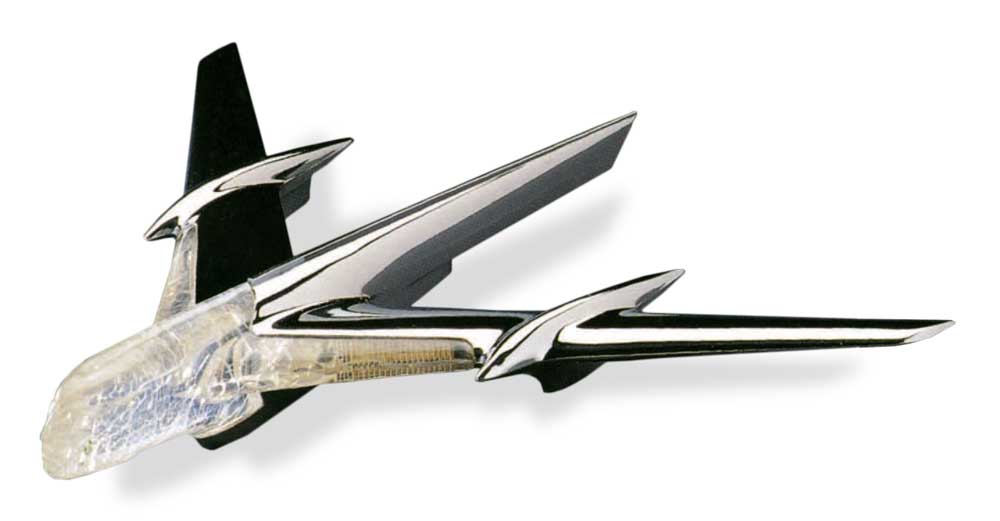General Motors’ announcement in 2009 of the closing of its Pontiac division made a stir across America where the car had been a staple for generations.

A 1955 Pontiac hood ornament, General Motors Corp. Photograph from BRIGHTWORK by Ken Steacy © 2000. Used with permission from Chronicle Books LLC, San Francisco.
Historic photos of the automobile were legion in the press and key among them were images of the dramatic Pontiac hood ornaments such as the amber-headed chieftain that took center stage on the front page of The New York Times, May 4, 2009. It is not surprising that the mascot was featured so prominently in the news since Pontiac’s ornaments are among the most striking from the flamboyant era of the American automobile. In the early 1930s they were shaped in the form of a Native American head adorned with feathered headdress, but by the 1950s they had morphed into the memorable configuration of jet plane with the head of Chief Pontiac at the helm. These beautiful and iconic designs caught the public imagination then and now, but, when contextualized to their own day, their significance expands. They can be understood as ciphers of industrial strength in the face of the complex and troubled situation for the Native American in postwar America.
The flying mascot’s sleek body trailing behind the bold, simplified features of Chief Pontiac is replete with glistening surface and tapering forms. Its swept wings were modeled after the jet aircraft of the period and in that regard symbolized the military might embodied in the Cold War fighters and bomber planes. In the words of one designer, “We liked jet airplanes, we liked flashiness, we liked power.”1 At work was a language of corporate power and machismo linked as much to planes as to tropes of the Native American male body.2 As the Indian body converts into its technological other, Pontiac’s ornament appropriates the raw power of the myth of the savage body so associated with the Indian warrior, and transforms it into a streamlined extension of the car’s force as moving energy. Indeed, the cultural stereotype of the Native American living freely in wide open space was in sync with fifties notions of jet-age freedom. A comparable mascot with other ethnicities no doubt would have been untenable. Many hood ornaments by carmakers in the fifties were modeled after jet planes, but Pontiac retained recognizable features on its mascots, specifically that of the canonical Indian head, making its pairing with the jet all the more suggestive.

A c. 1930 Pontiac radiator cap, General Motors Corp. Photograph by CSAndersen, Flickr.
Roland Barthes, writing his Mythologies from 1954-56, at the apogee of the development of the hood ornament, described advertising and other signifying systems as practices that served to artificially resolve social contra- dictions by making them appear natural.3 General Motors may have wanted to cash in on the primitivist trope of raw, savage energy and freedom, embodied in the conjunction of Indian body and jet plane, for its automobiles, but the car signified and sold much more. It captured and made “natural,” tensions in society during what was in reality, a problematic historical moment. In its hybrid and complex signification, the ornament speaks to the shifting identities of Native Americans in the postwar era when veterans returned from the front, hobbyists played Indian, termination of federal responsibility of Native American tribes became the official U.S. government policy, and the red power movement of the sixties was soon to be a reality. By allowing a difficult situation to seemingly be resolved within an elegant design, General Motors created a paradigm in this ornament of dissonant factions, and new cultural formations, being magically subsumed under the wings of corporate patronage. As Charlie Wilson, then the firm’s president, put it in 1953 when he accepted the position of Secretary of Defense, “I always thought that what was good for the country was good for General Motors, and vice versa.”4
About the Author: Mona Hadler is a Professor of Art History at Brooklyn College and the Graduate Center of the City University of New York.
There’s more! To read the rest of this article, members are invited to log in. Not a member? We invite you to join. This article originally appeared in theSCA Journal, Spring 2010, Vol. 28, No. 1. The SCA Journal is a semi-annual publication and a member benefit of the Society for Commercial Archeology.
More Articles Join the SCA


